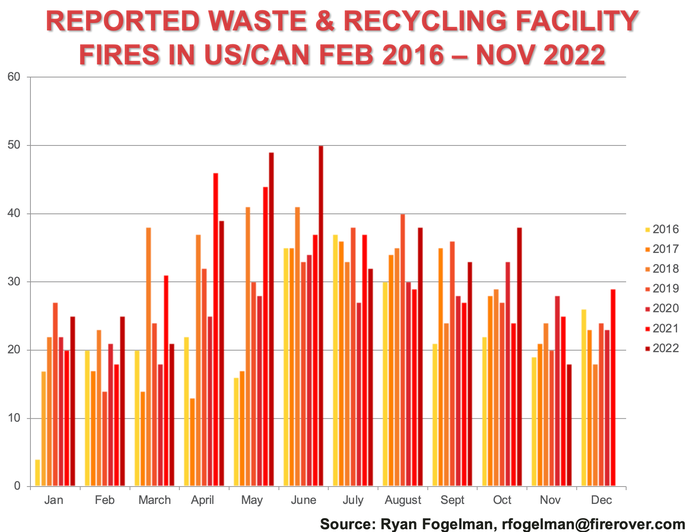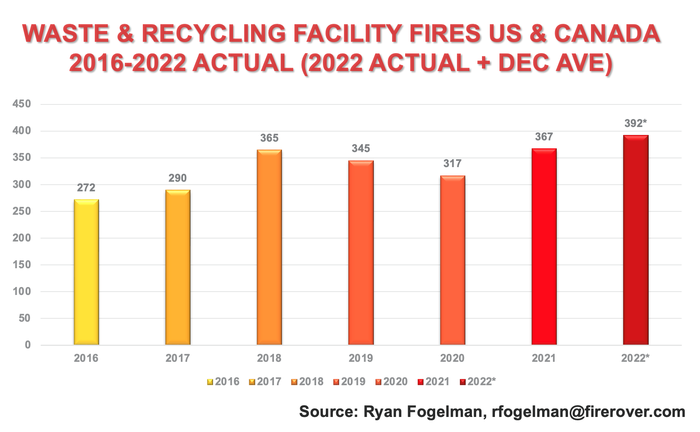2022 Officially the Worst Year for Waste and Recycling Facility Fires
The good news is we finally had a reprieve from the record months we have been experiencing in the waste and recycling industry this year. However in November, 2022 officially surpassed 2021 and 2018 as the worst year for waste and recycling facility fires in the U.S. and Canada with 268 fire incidents, and we still have the entire month of December to go.

The good news is we finally had a reprieve from the record months we have been experiencing in the waste and recycling industry this year. However in November, 2022 officially surpassed 2021 and 2018 as the worst year for waste and recycling facility fires in the U.S. and Canada with 268 fire incidents, and we still have the entire month of December to go.
November 2022 Fire Data
This year has been the worst year for fires since I began reporting waste and recycling facility fire incidents in 2016. In November, we experienced 18 publicly reported fire incidents in the U.S. and Canada. Twelve of these fire incidents occurred at waste, paper and plastic facilities; three occurred at scrap metal facilities; and one occurred at each a construction and demolition (C&D) facility, a hazmat operation and an organics facility. Although the numbers were down for reported fires across the industry, at Fire Rover, we responded to more than 100 fire incidents at our clients’ facilities.

It's Official
I want to make it 100% clear that the data I have been consolidating and analyzing since 2016 only includes the fire incidents that were “reported” by a media outlet or a government agency. In November, 2022 officially surpassed 2021 and 2018 as the worst year for waste and recycling facility fires in the U.S. and Canada since I began reporting the data in 2016.

I developed the graph above to show actual number data while also including 2022 actual data plus December’s historical average. As you can see, even with an average December from a historical perspective, 2022 will be one for the books. If I had to put money on it, we would come in above the average number and get close to the 400 annual fire incidents in 2022 we were on trend for until we came in far short this month.
Safety Knows No Competition
As one can imagine, at Fire Rover, we have a front-row seat to many different fire events, some caused by batteries, fireworks, accelerants and the like, in various waste and recycling occupancies such as municipal solid waste, paper, plastic, metals, scrap, e-scrap, hazmat, C&D and organics. Some of our clients allow the videos to be shared, and some do not. I do not judge as there are many perceived consequences that businesses deal with from a legal perspective, public perception perspective and industry perspective when they share their events, but it is always nice when we can share the videos. These videos allow us to learn from each other as we dissect each incident as well as educate the public on the dangers/hazards that improper recycling can cause.
With that being said, I am a firm believer in the philosophy of “safety knows no competition,” as I believe we can all learn from the fire hazards and incidents that are inundating our waste and recycling streams. Before we had a full understanding of the lithium-ion battery issue that has flooded our waste and recycling streams, there was a belief that “good operators” did not have fires. I hope that it is clear to all that although there is no substitute for solid operational procedures and execution, the fire hazards the industry faces are no fault of its own.
A global leader in waste and recycling, SUEZ, along with the Aberdeen, Scotland, City Council, released a very informative video that walks viewers through a fire incident that ultimately led to a catastrophic loss for the Athens East Mixed Recycling Facility. This incident on July 6 started as many of the fires we see started on the tip floor. The cause of the fire is anyone’s best guess, but based on my experience and most of the surveys I have seen, there is a greater than 50% chance that a lithium-ion battery started the initial fire.
As we walk through the video, there are several things to focus on:
4:04 p.m. – First sign of smoke was visible
4:35 p.m. – Automatic fire alarms are triggered
4:39 p.m. – Fire professionals are dispatched
4:44 p.m. – Fire professionals arrive onsite
4:47 p.m. – Automatic fire sprinkler triggered
4:48 p.m. – Fire professionals get site access
Cameras melt
As you can see, it took almost 30 minutes from the first sign of smoke—a symptom of an impending fire—for fire alarms to be triggered. There is a ton of opportunity during that time for solutions like the Fire Rover to pick up a thermal, smoke or flash signature, or a combination of these, that would trigger our agents to dispatch the fire professionals and/or suppress the actual event. Not only did it take 30 minutes from the first sign of smoke for the fire alarms to be triggered, but it took an additional 12 minutes for the sprinkler to go off. By that time, the sprinkler is only there to buy time for the fire professionals to get water on the fire. In this case, the fire professionals got to the site rather quickly; however, getting access to the site was another step that took some time away from their fight.
The fact is that most jurisdictions across the globe only require these facilities to be covered by standard sprinkler systems. Sprinkler systems are an amazing invention that have saved countless lives in commercial and residential facilities, and there are times when these systems work to put out fires in waste and recycling facilities. However, the issue is that they are not made for the initial or final extinguishment of a fire. Most of the time, they only hold the fires at bay until the fire professionals arrive on the scene to put the fire out.
The issue is all about time and response. If you are waiting for a sprinkler system to go off before the fire professionals are notified and dispatched, you are already behind the eight ball.
Take a look at this video from one of our clients’ incidents:
This is a thermal-only system. We were notified by the direct heat and smoke 10 to 15 minutes before a fire sprinkler system would have been activated. We dispatched the fire professionals within less than a minute of our agent verifying that a fire was happening. Had we had our full Fire Rover solution in place, we would have sprayed the scene within the same minute we dispatched the fire professionals, having the fire under control by the time the fire professionals arrived on the scene.
The fire professionals took more than 10 minutes to arrive on the scene and almost 15 minutes to get any water on the hazard. In this case, there was not a catastrophic loss to the building, but most fire professionals would agree that another 5 minutes would have been the difference between a total loss and our customers going back to work the next day.
Now watch the video above. We identify and suppress the fire well before any sprinklers, fire professionals or employees have to get involved. A night and day experience with little to no cleanup or downtime. Are they all this clean? Not a chance. What we do is hard, but so is fighting fires. These incidents are dangerous, stressful and unpredictable. There is no magic solution, but there are solutions out there.
A recent article was shared regarding a grant provided to help optical sorters pull batteries out of the waste and recycling stream during sorting. Until some of these technologies are a reality, we need to keep up the good fight of innovating, educating the public, training the firefighters and equipping them with the proper training to deal with these hazards. And the manufacturers of these hazards should be helping the industry foot the bill!
Conclusion
As we near the end of 2022, I am getting closer to beginning to work on my "Waste & Recycling Facility Fires Annual Report." Due to the increased fire incidents, this year’s report is gearing up to be an interesting one. To be first in line to get a copy, you can sign up and follow my newsletter, ��“Fire Safety Report.” Additionally, if you are attending WASTECON this week and want to connect in person, I will be presenting at the Safety Summit on Wednesday, December 7 at 1:45 p.m. PT in a session titled, “Managing Fires at Facilities and in Trucks.”
Ryan Fogelman, JD/MBA, is vice president of strategic partnerships for Fire Rover. He is focused on bringing innovative safety solutions to market, and two of his solutions have won the distinguished Edison Innovation Award for Industrial Safety and Consumer Products. He has been compiling and publishing the “Reported Waste & Recycling Facility Fires In The US/CAN” since February 2016 and the “Waste & Recycling Facility Fires Annual Report.” Fogelman regularly speaks on the topic of the scope of fire problems facing the waste and recycling industries, detection solutions, proper fire planning and early-stage fire risk mitigation. Additionally, Fogelman is on the National Fire Protection Association’s Technical Committee for Hazard Materials. (Connect with Ryan on LinkedIn at https://www.linkedin.com/in/ryanjayfogelman or email at [email protected])
About the Author
You May Also Like




.png?width=300&auto=webp&quality=80&disable=upscale)